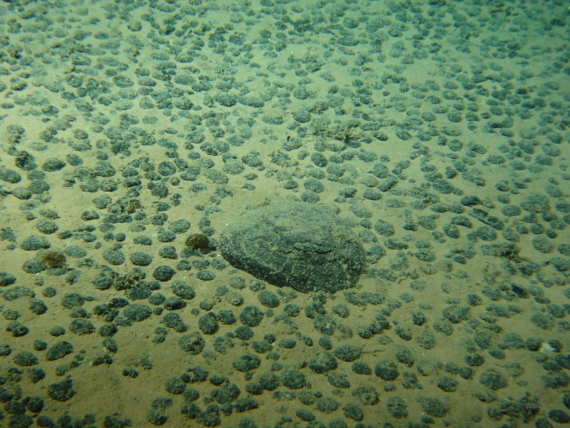Nodules
Polymetallic nodules were discovered at the end of the 19th century during a dredging operation on the oceanographic research vessel "Challenger". These blackish concretions are composed of concentric fine layers of ferric oxide and manganese which encompass a nucleus (a fragment of rock, an even older nodule or even a shark tooth). Their growth rate is very slow, only a few millimeters per million years (Ma). It is estimated that the nodules observable today are 10 to 15 Ma years old maximum which is relatively young compared to the age of Earth (4 500 Ma) but less if placed on the human scale ("Lucy" our Australopithecus ancester - lived 3 Ma ago).
Where can they be found?
Nodules are present in all the world's oceans and even in certain lakes (sometimes from depths of 400 m) if the sedimentation rate is low enough for them to continue to grow and to remain at the surface of the sediment (2 to 10 millimeters/1000 years). The highest concentration of nodules is in the Pacific, in the Carion-Clipperton zone at a depth of 5000 m. The variations in surface biological production, bathymetry, slopes, deep ocean currents and the source of metals (oxides precipitate from seawater and from sediment pore water) influence the size, morphology and chemical composition of the nodules. Nodules measure between 2 and 15 cm in diameter, the largest covering entire plains with up to 30 kg/m². The nodules in this zone contain manganese (29 %), iron (6 %), and also other, more strategic metals such as nickel (1,3 %), copper (1,15 %), cobalt (0,25 %) and trace metals and rare earths.
Why are they of interest to us?
The idea that nodules could be a source of metals was developed in the 1960s. They were intensively researched in the 1970s and 80s. However, their interest as a mineral resource was rapidly declined (low profitability and difficult exploitation techniques due to their depth and distance). They were therefore never exploited. However, with the ever-increasing depletion of land resources, the interest in marine mineral resources has revived
Ifremer owns an exploitation permit delivered by the International Seabed Authority which manages the exploration - and maybe soon the exploitation - of deep sea mineral resources in international waters.
Ifremer's current activities on nodules concentrate on the following:
- sedimentary environment/nodule facies interactions to better understand the processes determining their size, morphology and chemistry ;
- evaluation of the resource and search for nodule-rich zones and those favourable for potential exploitation ;
- development of new exploration tools (AUV 6000 m) ;
- biological study of the deep sea environment in view of its protection in the case of exploitation as many different organisms (anemones, sea cucumbers, shrimps, worms) and micro-organisms inhabit nodules and their surrounding environment.









